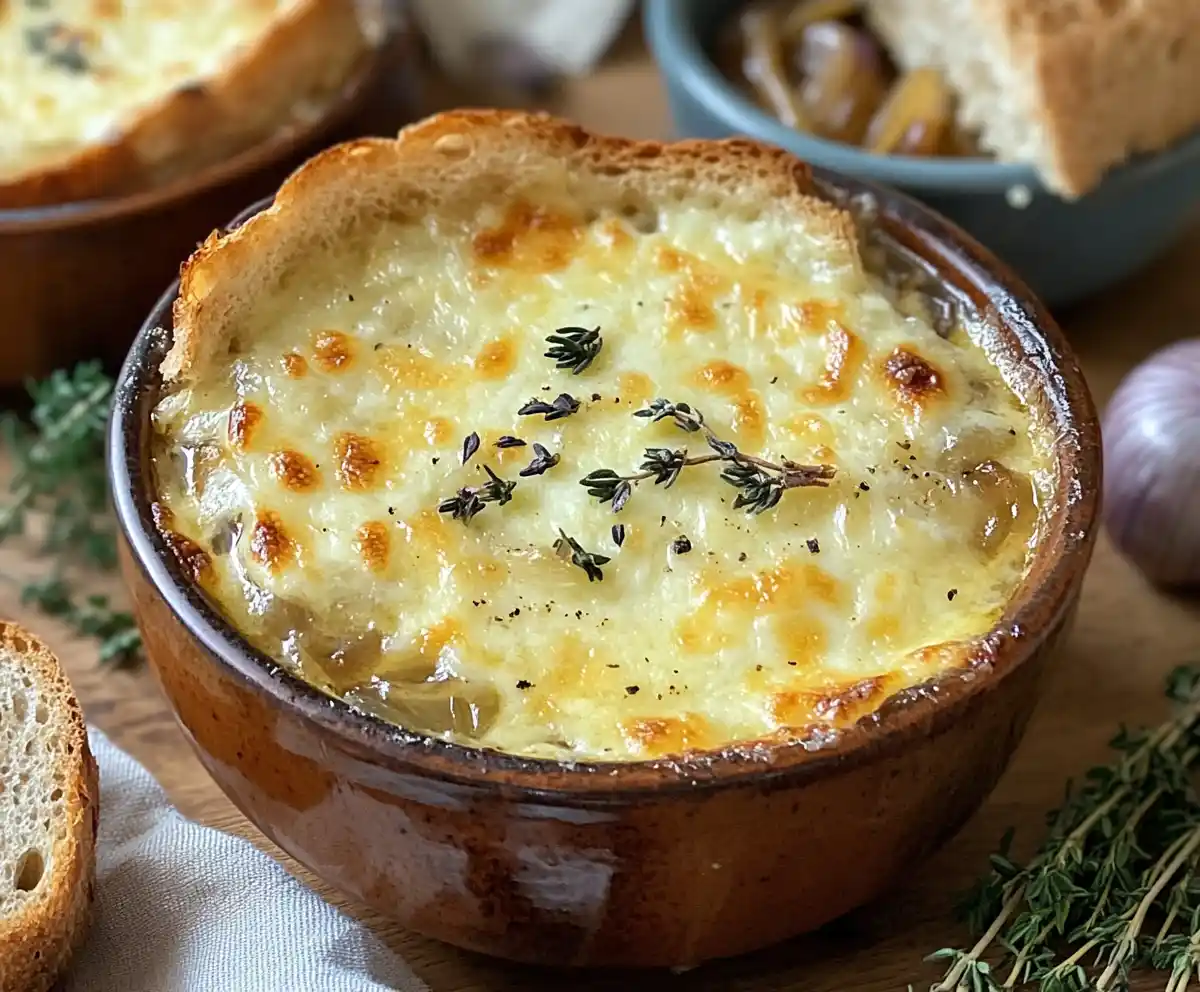
Introduction: A Deep Dive into French Onion Soup
There’s something undeniably comforting about a warm bowl of French Onion Soup. This classic dish, with its caramelized onions, hearty broth, and gooey cheese topping, has stood the test of time. Whether you’re a seasoned chef or a curious foodie, understanding the roots and making of French Onion Soup will deepen your appreciation for this culinary gem. In this article, we’ll explore its history, essential ingredients, step-by-step preparation, and tips to perfect this beloved recipe. So, let’s grab a spoon and dive in!
What is French Onion Soup?
Origins and History of French Onion Soup
French Onion Soup, or soupe à l’oignon gratinée, has its roots in 18th-century France. Historically, it was considered a “poor man’s dish” because onions were inexpensive and easy to grow. Over time, it transitioned from humble beginnings to becoming a staple in fine dining. The addition of bread and cheese, melted to golden perfection, elevated it from simple fare to a luxurious indulgence.
This soup’s transformation owes much to French chefs who refined its flavors and presentation. Today, it represents the essence of French culinary tradition: simplicity, elegance, and attention to detail.
What Makes French Onion Soup Unique?
What sets French Onion Soup apart from other soups is its perfect balance of flavors and textures. Caramelized onions provide a rich, sweet base, while beef broth adds depth and heartiness. The pièce de résistance? A layer of crusty bread topped with bubbly, melted cheese that brings a satisfying crunch to every bite.
Unlike many soups, French Onion Soup is both a starter and a main course, making it versatile for any occasion. Its comforting warmth and indulgent toppings have earned it a place on menus worldwide.
Ingredients for Perfect French Onion Soup
Key Ingredients You’ll Need
Creating the perfect French Onion Soup starts with high-quality ingredients. At the heart of this dish are onions, specifically yellow onions, prized for their natural sweetness when caramelized. Alternatively, you can use white or red onions for a different flavor profile, but yellow onions remain the classic choice.
The broth or stock plays a crucial role in building flavor. A robust beef stock is traditional, lending depth and richness. However, vegetarians can substitute vegetable broth while still achieving a hearty taste. Adding a splash of dry white wine or sherry enhances the broth’s complexity, giving the soup a subtle tang.
No French Onion Soup is complete without bread and cheese. A slice of crusty baguette serves as the base for the cheesy topping. For the cheese, Gruyère is the gold standard due to its melting properties and nutty flavor. You can also try Swiss cheese or mozzarella as alternatives.
Optional Ingredients for Flavor Boosts
To take your French Onion Soup to the next level, consider adding fresh herbs like thyme and bay leaves. These herbs infuse the broth with a fragrant aroma that complements the caramelized onions.
For a touch of elegance, finish the soup with a drizzle of truffle oil or sprinkle freshly cracked black pepper for a kick. These small additions can transform a traditional dish into a gourmet masterpiece.
Step-by-Step Guide to Making French Onion Soup
Preparing the Onions

The secret to a great French Onion Soup lies in the caramelized onions. Start by slicing the onions thinly and evenly. Heat butter in a heavy-bottomed pot, then add the onions with a pinch of salt. Stir frequently over low to medium heat, allowing the natural sugars to develop into a rich, golden-brown color. This process can take up to 45 minutes, but patience is key—burnt onions will ruin the soup’s flavor.
To deglaze the pan, pour in a splash of white wine or sherry, scraping up any browned bits. This step intensifies the flavor and ensures the onions achieve their full potential.
Assembling and Finishing the Soup
Once the onions are perfectly caramelized, add your chosen broth, thyme, and bay leaves. Let the soup simmer gently to meld the flavors. Season with salt and pepper to taste.
When it’s time to serve, ladle the soup into oven-safe bowls. Place a slice of baguette on top, followed by a generous layer of Gruyère cheese. Broil in the oven until the cheese bubbles and turns golden brown.

Variations and Modern Twists on French Onion Soup
Vegetarian and Vegan Alternatives
For those who prefer plant-based options, French Onion Soup can be just as rich and satisfying without the traditional beef stock. Replace the beef broth with a well-seasoned vegetable broth to retain depth of flavor. Adding mushrooms to the caramelized onions enhances the umami profile, making it an excellent substitute for meat-based ingredients.
For a vegan version, use plant-based butter for caramelizing the onions and top the soup with a slice of crusty bread spread with a vegan cheese that melts well, such as almond-based mozzarella. This version offers all the comfort of the classic dish while staying fully plant-based.
Creative Additions and Fusion Recipes
Experimenting with flavors is a great way to put a modern twist on French Onion Soup. Adding a touch of spice with chili flakes or cayenne can create a bold variation that pairs wonderfully with mild cheese. For a touch of luxury, consider drizzling truffle oil over the melted cheese just before serving.
Another creative take involves incorporating regional spices like cumin or paprika for a unique fusion. Some chefs even use beer or cider instead of wine for a rustic, earthy flavor. These creative additions breathe new life into the traditional recipe.
For more inventive soup ideas, explore our unique recipe collection, featuring surprising twists on classics.
Storage, Reheating, and Freezing Tips
How to Store French Onion Soup
Proper storage ensures your French Onion Soup stays fresh and flavorful. Allow the soup to cool completely before transferring it to an airtight container. Store the broth separately from the bread and cheese to maintain their textures. Refrigerated soup lasts up to four days when stored correctly.
For longer storage, consider freezing. Portion the soup into individual containers, leaving some space for expansion. Avoid freezing the bread and cheese, as they don’t freeze well.
Reheating and Freezing Tips
Reheating French Onion Soup is simple and straightforward. Warm the soup gently on the stovetop, stirring occasionally to maintain the creamy consistency. If you froze the soup, thaw it overnight in the refrigerator before reheating.
To serve, ladle the hot soup into oven-safe bowls, add the bread and cheese, and broil until the topping is golden and bubbling. This method ensures that your reheated soup tastes just as good as fresh.
For more tips on reheating and serving, check out our guide to making the perfect classic dish.
Frequently Asked Questions About French Onion Soup
What type of onions are best for French Onion Soup?
Yellow onions are the top choice for making French Onion Soup because of their natural sweetness and ability to caramelize beautifully. If you’re looking for a twist, white onions add a milder flavor, while red onions bring a slightly tangier taste. The key is to cook them slowly to release their sugars and achieve a rich, golden color.
Can I make French Onion Soup without alcohol?
Absolutely! While wine or sherry adds depth to the soup, you can skip it or replace it with apple cider vinegar or lemon juice for acidity. Simply adjust the broth seasoning to balance the flavors, ensuring your soup retains its signature taste.
How do I get the perfect caramelized onions?
Patience is the secret to caramelizing onions perfectly. Cook them over low to medium heat, stirring frequently. Adding a pinch of sugar can help speed up the process, but avoid rushing by turning up the heat—it risks burning the onions and ruining the soup.
What are good substitutes for Gruyère cheese?
If Gruyère isn’t available, try Swiss cheese, Comté, or Emmental. For a more affordable option, shredded mozzarella works well, though it lacks the nutty richness of Gruyère.
Why French Onion Soup is a Timeless Classic
A Dish That Transcends Generations
Caramelized onions has remained a favorite for centuries because of its comforting flavors and rich heritage. Its humble beginnings as a farmer’s dish have evolved into a culinary masterpiece served in fine restaurants worldwide. The combination of caramelized onions, savory broth, and melted cheese creates a harmony that’s hard to resist.
This dish also adapts well to various dietary preferences, offering vegetarian and vegan versions without losing its essence. Its simplicity makes it approachable for home cooks, while its elegance impresses dinner guests.
Why You Should Try Making It at Home
Preparing Caramelized onionsFrench Onion Soup at home is an experience that combines art and tradition. The slow process of caramelizing onions, layering the soup with bread and cheese, and broiling it to golden perfection is as satisfying as eating it. Plus, you can customize it with your favorite ingredients and pair it with a glass of wine or a fresh salad for a complete meal.
Whether it’s a cold winter evening or a casual dinner with friends, Caramelized onions fits any occasion. It’s more than a dish—it’s a celebration of flavor, comfort, and the joy of cooking.
These sections highlight French Onion Soup‘s enduring appeal and answer common questions to guide readers in making the dish their own. Let me know if you’d like further edits or additional insights!
Pairing French Onion Soup with the Perfect Accompaniments
The Best Side Dishes for French Onion Soup
Pairing Caramelized onions with the right side dishes elevates the dining experience. A crisp green salad, dressed lightly with lemon vinaigrette or balsamic glaze, balances the soup’s richness. Adding nuts or dried cranberries to the salad enhances the texture and flavor, creating a complementary contrast.
For heartier options, serve the soup with crusty garlic bread or buttery dinner rolls. These additions are perfect for dipping into the savory broth, making every bite even more satisfying. Roasted vegetables, such as asparagus or zucchini, also pair wonderfully, offering a touch of freshness to the meal.
Drinks That Complement French Onion Soup
The right drink can bring out the best in Caramelized onions. A full-bodied red wine, like a Cabernet Sauvignon or Merlot, enhances the soup’s deep, caramelized flavors. If you prefer white wine, try a dry Chardonnay for its crisp, buttery notes.
Non-alcoholic options like sparkling water with lemon or a light, fruity iced tea offer refreshing alternatives. These drinks cleanse the palate between bites, allowing you to fully savor the soup’s rich taste.
Final Thoughts on French Onion Soup
A Culinary Icon Worth Celebrating
French Onion Soup has earned its place as a culinary icon because it combines simplicity and sophistication. Its ability to transform humble onions into a dish of such depth and flavor is a testament to the beauty of French cooking. The comforting warmth of the soup, topped with gooey cheese and crisp bread, makes it a favorite for people worldwide.
This dish is not only timeless but also incredibly versatile. Whether you’re hosting a fancy dinner party or enjoying a quiet evening at home, Caramelized onions always feels special. Its adaptability to various dietary preferences ensures that everyone can enjoy its rich, hearty flavors.
Why You Should Make It Your Next Meal
Making Caramelized onions at home is an experience that brings joy to both cooking and dining. From caramelizing the onions to melting the cheese, each step connects you to centuries of culinary tradition. Moreover, this soup offers an opportunity to experiment with flavors, whether you choose to stick with the classic recipe or add your own modern twist.
So, the next time you’re craving something comforting and flavorful, consider French Onion Soup. It’s more than just a meal—it’s a celebration of the art of cooking and the simple pleasure of sharing food with loved ones.
These final sections provide pairing ideas and celebrate the enduring appeal of French Onion Soup. Let me know if you’d like further refinements or additions!

